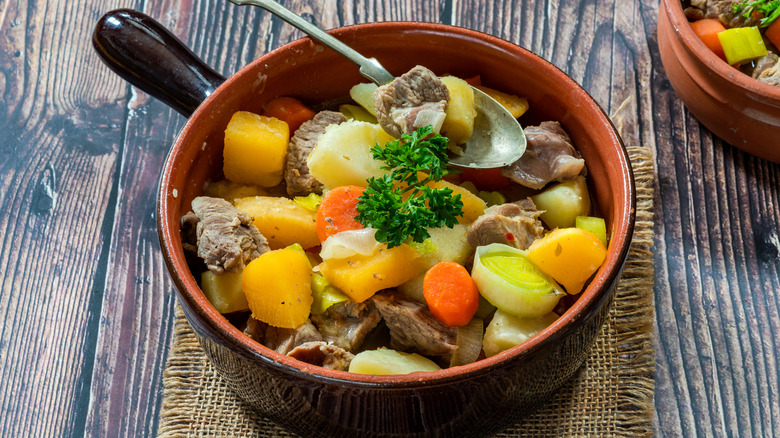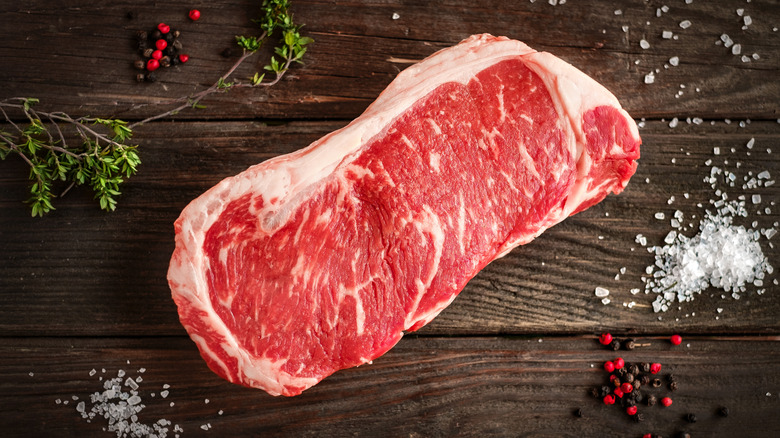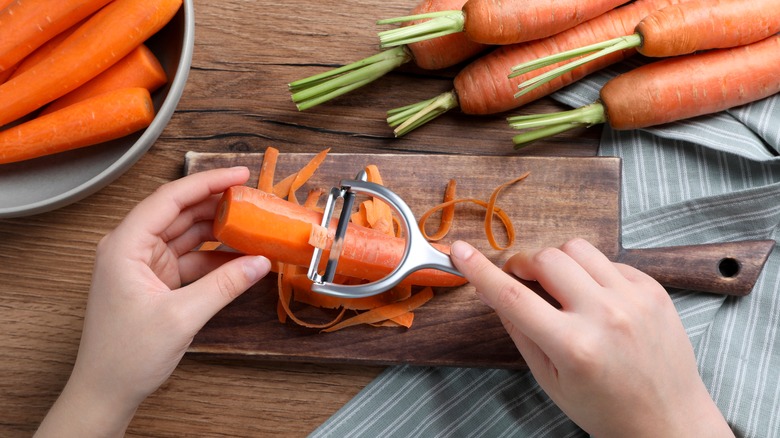Cawl: The Meaty Welsh Stew That's A Comforting Classic
There are few things more comforting on cold, rainy days than a steaming bowl of hearty stew. And, with a near-perennial climate like that in the U.K., its four constituent nations have figured out how to make some of the best stew in the world. From Scotland's spicy Scottish rabbit curry to Liverpool's scouse to Northern Ireland's namesake stew, the Brits have long known how to perfect a meat and potatoes dish.
However, it may just be Wales that has some of the best stews to savor during the winter months. Tatws pum munud, which translates to five-minute potatoes, features plenty of staple stew ingredients but is made in a frying pan. Even nearby Liverpool's scouse is commonly enjoyed in Wales as its classic form has been deeply influenced by Welsh migrants. But, it's likely cawl that is the most popular and quintessential Welsh stew in and out of the country.
Cawl is a traditional dish that typically features Welsh lamb or beef alongside plenty of root vegetables. While styles of the stew can vary by season or Welsh region, this comforting classic has been around for centuries and continues to warm the souls of many Welsh people today.
History of cawl
Cawl is often known as "cawl Cymreig" in Wales, which translates simply to Welsh soup. Being the nation's namesake, it is clear this soup has important and traditional ties to the Welsh people.
It is near impossible to find the exact origins of cawl. It has taken many different forms over the centuries and has featured differing ingredients and preparation methods. According to National Geographic, the stew started being made way before written records existed. Welsh cooks dating back thousands of years have been boiling pots of water over heated stones. And, when the Romans finally brought large self-standing cauldrons to what is now Wales, this cookware was used to make cawl into the 20th century.
However, it wasn't until the end of the 20th century that cawl as we know it was made — a dish with lamb or beef, bacon, and a reliable lineup of root vegetables.
Today, this dish is often served on March 1, the Welsh holiday of St. David's Day. Between the parades and other holiday rituals, cawl is enjoyed in homes across the nation. Prepared in many different variations and often served in a unique way, this dish is truly a beloved Welsh classic.
Ingredients in cawl
Traditionally, there are many meat components that make up a classic Welsh cawl. Welsh lamb or beef is often the main meat in the stew, and bacon typically makes an appearance as well. Fat from the bacon or lard is often used as the fat of choice to cook the ingredients in, rather than using oils or butter.
When it comes to tasty root vegetables, this dish has it all. Onions, potatoes, carrots, parsnips, and rutabaga are the main veggies included in this dish. However, The Spruce Eats notes that this lineup can often change due to what is currently in season or switches up to account for regional preferences. While not a root vegetable, celeriac, leek, or celery are also often added towards the end of the cooking time to add texture, flavor, and color to the dish.
Seasonings usually include the addition of a bay leaf along with a few sprigs or thyme. Salt and pepper to taste are also good for seasoning the meat before it is seared and added to the broth to boil.
So, if you're looking for both a completely filling and no-stress meal that warms you up while giving you your daily dose of veggies, look no further than a Welsh cawl.
How cawl is made and eaten
Making cawl is similar to making any other stew, so you should feel confident whipping up this comforting classic in no time.
The first step is to cook the onions until brown in a large pot, and then toss in the meat. Once sufficiently seared, the stock and water are added to the pot, and the meat is boiled until tender. This concoction is then removed from the heat and left in the fridge overnight, where all the flavors will infuse each other.
The next day, any floating fat is removed and the prepared vegetables are thrown in to cook with the other ingredients. Once everything is adequately boiled, the meat can be removed to be sliced into bite-size pieces, if necessary. The chopped meat can be added back in, and the stew is ready to be served.
One of the unique aspects of serving cawl is the broth is often served separately from the meat and vegetables. The infused soupy broth can be enjoyed as a starter course and the chunky ingredients as a main dish. That said, serving them together is fine and enjoyable as well. Just make sure to serve it warm alongside bread and cheese — ideally Caerphilly or cheddar — for the complete Welsh experience.



